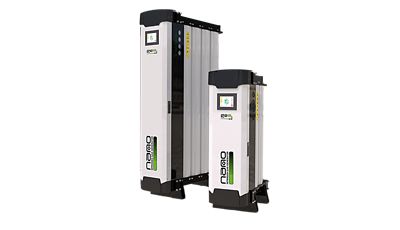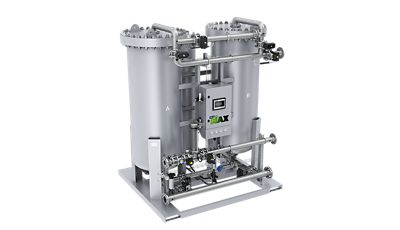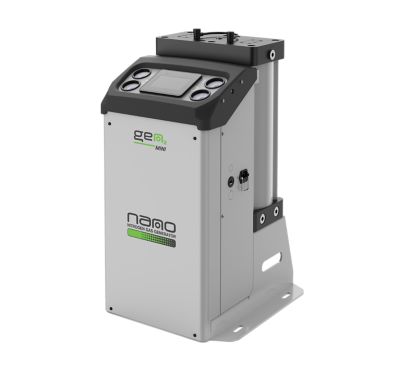In the oil and gas industry, safety and product integrity aren’t negotiable, they’re essential. Managing the atmosphere inside storage tanks, pipelines, and process vessels is a key part of protecting valuable assets, extending equipment life, and safeguarding people and facilities.
Two of the most common ways operators achieve this are nitrogen blanketing and nitrogen inerting. While these terms are sometimes used interchangeably, they’re not the same thing. Understanding when to blanket and when to inert can mean the difference between safe, reliable production and an unexpected shutdown.
In this article, we break down the difference between blanketing and inerting, why each method matters, and how on-site nitrogen generation can simplify both.
What Is Nitrogen Blanketing?
Nitrogen blanketing, sometimes called tank blanketing or padding, is the process of maintaining a protective layer of nitrogen gas in the vapor space above a stored liquid.
Think of a storage tank holding thousands of barrels of crude oil, refined fuel, or volatile chemicals. As temperatures fluctuate, the liquid expands and contracts, creating vapors that can mix with oxygen. This vapor space is where fire or explosion risks exist if oxygen levels rise too high.
By maintaining a constant, controlled nitrogen blanket, operators keep oxygen levels below the threshold for combustion. The result? Less oxidation, reduced product degradation, and minimized risk of ignition.
Typical applications for nitrogen blanketing include:
- Crude oil storage tanks
- Refined fuel tanks
- Petrochemical and chemical storage
- Food-grade oil storage
How it works:
A nitrogen supply, typically fed by an on-site nitrogen generator, maintains a slight positive pressure inside the tank. When the liquid level drops or the vapor space expands, nitrogen automatically fills the void to maintain a safe atmosphere.
Benefits of blanketing:
Reduces explosion and fire risk
Prevents oxidation of stored products
Maintains product quality
Minimizes corrosion inside the tank
What Is Nitrogen Inerting?
While blanketing maintains a stable nitrogen atmosphere during storage, inerting uses nitrogen to purge or displace oxygen and other flammable gases before or after specific operations.
For example, before maintenance work on a pipeline, it’s critical to remove any residual hydrocarbons or explosive gases. Nitrogen inerting flushes the system, replacing the dangerous mix with a non-reactive nitrogen atmosphere. This ensures a safe environment for maintenance crews and equipment.
Common inerting applications include:
Pipeline purging and commissioning
Clearing vessels before entry
Preparing tanks for cleaning or product changeover
Decommissioning pipelines or storage tanks
Switching between incompatible gases or liquids
How it works:
Nitrogen is introduced into the vessel or pipeline at a higher flow rate than blanketing, pushing out oxygen, moisture, or flammable gases until safe levels are reached. The process may involve multiple purge cycles and precise monitoring to verify a fully inert condition.
Benefits of inerting:
Prevents combustion during maintenance or changeover
Reduces fire and explosion hazards
Ensures compliance with safety standards
Provides a controlled, inert environment for repairs or shutdowns
Blanketing vs. Inerting: A Clear Comparison
Both blanketing and inerting rely on nitrogen’s inert properties to protect processes, products, and people. However, they differ in purpose, flow rates, timing, and execution.
Here’s how they compare at a glance:
Feature
|
Blanketing
|
Inerting
|
|---|---|---|
Purpose
|
Maintain a safe vapor space
|
Purge oxygen and flammable gases
|
Where used
|
Storage tanks
|
Pipelines, vessels, tanks
|
Flow rate
|
Low and continuous
|
High and intermittent
|
Operation
|
Ongoing during storage
|
Performed before/after work
|
End goal
|
Prevent oxygen ingress
|
Displace hazardous gases
|
Equipment
|
Low-pressure regulators, valves
|
High-flow supply, purge equipment
|
Storage Tanks vs. Pipeline Purging
In practical terms, blanketing is almost always used for storage tanks, anywhere a flammable or sensitive liquid sits for extended periods. The steady nitrogen blanket minimizes contact with air, stopping oxidation and combustion risks at the source.
Pipeline inerting is more dynamic. Oil and gas pipelines must often be purged before commissioning, during shutdowns, or when switching from one product to another. Inerting safely clears out any residual gases that could ignite or contaminate the next product in line.
Why On-Site Nitrogen Generation Makes Sense
Traditionally, many facilities have relied on delivered nitrogen cylinders or bulk liquid nitrogen for blanketing and inerting needs. But transporting, storing, and managing delivered nitrogen can be costly, time-consuming, and inflexible, especially for operations with fluctuating demand.
On-site nitrogen generation changes that. By producing nitrogen on demand, right where it’s needed, oil and gas operators gain more control over purity, flow, and costs.
Benefits of on-site nitrogen generation for blanketing and inerting:
Cost savings: Eliminate ongoing delivery fees and rental charges.
Purity control: Adjust nitrogen purity to meet your specific safety standards.
Operational flexibility: Scale supply up or down as process demands change.
Reduced downtime: Always have nitrogen available for routine blanketing and emergency inerting.
Safety and sustainability: Reduce truck traffic and handling risks compared to bulk nitrogen deliveries.
At nano-purification solutions, we design nitrogen generation systems built for the oil and gas industry’s rigorous requirements. From low-flow blanketing systems to high-capacity inerting units, our equipment delivers reliable, continuous nitrogen with minimal maintenance and maximum efficiency.
Choosing the Right Solution
Selecting between blanketing and inerting isn’t a matter of either/or, most oil and gas operations use both methods at different points in their processes.
The key is knowing when each approach makes sense:
Use blanketing to protect stored products and maintain long-term tank safety.
Use inerting to safely purge pipelines or vessels before maintenance, product changeover, or decommissioning.
And with on-site nitrogen generation, you have a consistent, cost-effective supply for both.
Experience. Customer. Service.
At nano-purification solutions, we believe reliable nitrogen shouldn’t be complicated. Whether you’re blanketing tanks or purging pipelines, our goal is to keep your operation safe, efficient, and compliant, without the headaches of managing delivered gas.
Talk to a nano Nitrogen Expert
Ready to improve your blanketing or inerting operations? Let’s find the right nitrogen solution for your oil and gas application. Contact our team today to discuss your process and discover how on-site nitrogen generation can work for you.





